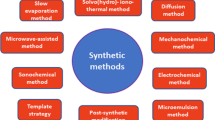Abstract
Catalytic wet air oxidation (CWAO) of o-chlorophenol in wastewater was studied in a stainless steel autoclave using four different Fe catalysts in the temperature range of 100–200°C. Experimental results showed that high rate of o-chlorophenol and CODCr (Chemical Oxygen Demand, mg/L) removal by CWAO was obtained at relatively low temperature and pressure. The catalysts Fe2(SO4)3, FeSO4, Fe2O3 and FeCl3 all exhibited high catalytic activity. More than 93.7% of the initial CODCr and nearly 100% of o-chlorophenol were removed at 150°C after 150 min with FeSO4 as catalyst. The CWAO of o-chlorophenol was found to be pseudo-first order reaction with respect to o-chlorophenol, with activation energy of 75.56 kJ/mol in the temperature range of 100–175°C.
Similar content being viewed by others
References
Lei, L., Wang, D., 2000. Wet oxidation of PVA-containing desizing wastewater.Chinese J. of Chem. Eng.,8(1):52–56 (in Chinese).
Li, L., Chen, P., Earnest, F., 1991. Generalized kinetic model for wet oxidation of organic compounds.AIChE Journal,37(11):1687–1697.
Lin, K.S., Wang, H.P., 1999. Rate enhancement by cations in supercritical water oxidation of 2-chlorophenol.Environ. Sci. Technol.,33(18):3278–3280.
Lin, K.S., Wang, H.P., 2000. Byproduct shape selectivity in supercritical water oxidation of 2-chlorophenol effected by CuO/ZSM-5.Langmuir,16(6):2627–2631.
Lin, K.S., Wang, H.P., Yang, Y.W., 1999. Supercritical water oxidation of 2-chlorophenol effected by Li+ and CuO/zeolites.Chemosphere,39(9):1385–1396.
Robert, K., Robert, B.C., 1985. Toxicity to daphnia of the end products of wet oxidation of phenol and substituted phenols.Water Res.,19(6):767–772.
Santos, A., Yustos, P., Durban, B., Carcia-Ochoa, F., 2001. Catalytic wet air oxidation of phenol: Kinetics of the mineralization rate.Industrial Engineering and Chemical Research,40:2773–2781.
Shende, R.V., Mahajani, V.V., 1997. Kinetics of wet oxidation of formic acidandacetic acid.Industrial Engineering and Chemical Research,36:4809–4814.
US Environmental Protection Agency, 1988. National Pollutant Discharge Elimination System, Code of Federal Regulations, 40, Part 122. US Government Printing Office, Washington, DC.
Wu, Y.C., Hao, O.J., Olmstead, D.G., Hsieh, K.P., Scholze, R.J., 1987. Wet air oxidation of anaerobically digested sludge.J. WPCF,59(11):39–45.
Wu, Q., Hu, X.J., Yue, P.L., 2003. Kinetics study on catalytic wet air oxidation of phenol.Chemical Engineering Science,58:923–928.
Author information
Authors and Affiliations
Corresponding author
Additional information
Project (No. 20407015) supported by the National Natural Science Foundation of China
Rights and permissions
About this article
Cite this article
Xu, Xh., He, P., Jin, J. et al. Fe salts as catalyst for the wet oxidation of o-chlorophenol. J Zheijang Univ Sci B 6, 569–573 (2005). https://doi.org/10.1631/jzus.2005.B0569
Received:
Accepted:
Published:
Issue Date:
DOI: https://doi.org/10.1631/jzus.2005.B0569




